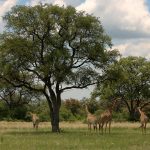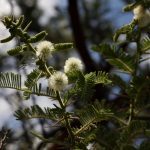TREE LIFE
FEBRUARY 1989
MASHONALAND CALENDAR
Tuesday 19th February 1989 : Botanic Garden walk at 165 hours for 1700 hours. This walk will be particularly interesting because Mr. Tom Muller will be showing and talking about some of the trees found on the recent outing to Nyazengu Nature Reserve on the slopes of Inyangani.
Sunday 19th February 1989 : Klein Kopjes – Concession area. Nikki and Ian Bates will be our hosts on this day at Klein Kopjes Farm, Concession. Meet there at 0945 hours.
Saturday 25th February : Mukuvisi Woodlands meeting at 1500hours. Meet at the Paget Road/Inyanga Gate.
Tuesday 7th March : Botanic Garden walk 1500 hours.
MATABELELAND CALENDAR
On Sunday February 5th we will have our Annual General Meeting, after an outing to Hillside Dams, about 1030 hours or so. Meet at 0830 hours below the Aloe Garden.
MATABELELAND NOTES
On Sunday, December 11th we had an extra meeting, actually replacing the January one, at Steadfast Park in the Matopos. This is the Boys’ Brigade Camp there and was occupied by some 20 boys from St. Georges College, Harare, with Mr. Rob Burrett, in charge. We had arranged to introduce them to the area, and to show them some of the trees and so on. Our Chairman, Ken Blake, had brought some fine tree drawings for the boys, which greatly helped, and we realised what an excellent school teacher was lost in him! We had last visited the area in July 1986 and this time we found some dozen tree species, not previously seen there, out of some 80 identified.
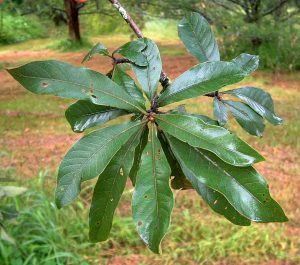
Terminalia trichopoda. Photo: R.Burrett. Source: Flora of Zimbabwe.
Among those we saw this time were – Acacia gerrardii, Acokanthera rotundata (schimperi), Cassia abbreviate, with a very long pod, Catha edulis in flower, Commiphora schimperi, Cussonia natalensis, Dichrostachys cinerea, usually a single plant only, Elephantorrhiza goetzei, Erythrina latissima, Euphorbia ingens and notably E. matabelensis with its smooth grey spine tipped branchlets arranged in whorls of 3,from last years growth (in spite of the name we rarely see it in these parts – it is far commoner in Mashonaland). Ficus glumosa, F. sur, F. thonningii, Grewia flava, Heteropyxis dehniae, Kirkia acuminata, flowering, Maytenus heterophylla subsp puberula, the Matopos subspecies Ozoroa insignis subsp, reticulata in flower (incidentally many in the Matopos are still flowering now in January, although they usually flower in the pre-rainy season and the very early rains); Pterolobium stellatum, Rhus leptodictya, R. pyroides, Sclerocarya birrea, Steganotaenia araliaccea, Strychnos madagascariensis, Tarenne neurophylla, Terminalia trichopoda, Tetradenia brevispicata, (iboza), Vangueria infausta. Near some of the Euphorbia matabelensis we found a small dry pool of blood, marking where some of the boys had earlier found a sable caught in the wire fence and had freed it. Quite an experience to remember. In the afternoon we took the boys to the old Railway Terminus area, with some fine Acacia galpinii, a pair of guinea fowl running around and Black Eagles overhead.
C. Sykes
MOLLY KILPERT: It is with deep regret that we record the passing of our friend and fellow tree-lover, Molly Kilpert. She leaves behind the memory of her throaty laughter that had become a regular part of our outings. As a committee member Molly took pride in doing the donkey work, despite her many commitments. But more important than her obvious delight in simple pleasures and never ending cups of tea for unexpected visitors, is Molly’s philosophy which is best illustrated in her garden; plan for tomorrow but live for today. Seedlings and saplings may become magnificent trees but don’t delay appreciation till then, enjoy them now. A few years ago Molly worked hard creating a rose garden along side a company house, a month or so after Killy had retired they revisited the house to find the entire rose garden paved for a parking lot. Molly’s philosophy accepts such eventualities, knowing that the pleasure and satisfaction associated with the preparation cannot be destroyed. In a world of uncertainty we can all gain from this positive philosophy. We share our sympathy with Molly’s family.
Kim Damstra.
BOTANIC GARDEN WALK, JANUARY 1989
This month we looked at the ANNONACEAE and began by examining the large flowers on Cananga adorata, the Ylang-ylang. The oil extracted from these flowers is one of the fragrant essential oils used in the perfume trade or as a lubricant during massage. Of all our indigenous families with tree representatives the ANNONACEAE is the most primitive and many families of these primitive features are seen in the flower. Firstly it only has 3 sepals and 3 + 3 petals. This is unusual in a plant that has net-veined leaves (a Dicotyledon), these plants usually have petals in multiples of 4 or 5. In contrast plants with parallel veined leaves (monocotyledons) often have petals in 3’s. In the ANNONACEAE the many anthers are short and the ovaries are not fused to one another in the beginning, this leads to interesting fruits. Their similar vegetative features are significant, the simple, alternate leaves, often obovate and with a slight blue-green tinge, held in a flat plane along the horizontal branches. They lack stipules, this important feature distinguishes them from those EUPHORBIACEAE that resemble them. Our walk was much more exciting than we had expected because we discovered fruit on
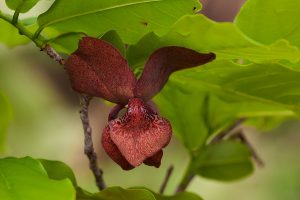
Monodora junodii . Photo: Bart Wursten. Source: Flora of Zimbabwe
Monodora junodii, Hexalobus monopetalus, Xylopia parviflora and Friesodielsia obovata. Tom’s Monodora have never fruited before so this was a first for all of us. The flowers on these trees decorated our Halloween table last year and the fruits are not yet ripe by the end of January. They resemble custard apples ANNONA in which all the ovaries swell and become fused into a rough sphere. In all the other fruits that we saw the individual ovaries became elongated and do not fuse to each other but radiate outwards in a bunch. The constrictor between each seed made them look like chubby fingers. In Hexalobus the fruit are fat and resemble peanuts, we may remember seeing Hexalobus in flower in Matepatepa last year. The fruit of Xylopia and Friesodielsia are very similar. Many of the ANNONACEAE have a colourful fruit and in general they are edible. The Xylopia was covered in green fruit although the seeds are surrounded by a bright red flesh that dries to brown. Friesodielsia was in flower and fruit at the same time. These are real showstoppers in the Zambezi Valley. One school I taught ran from one fruiting tree to the next, they also discovered that the fruits float and can be used to play “Pooh sticks” or, in scientific terms “investigate the differential surface flow of a moving water body”. Chris Nugent plays a more sophisticated version of this with oranges in the Zambezi – but the oranges need to be collected so as not to pollute the water. This game is also known as “paddling to exhaustion” or “avoid the hippo”. Whilst still in the Zambezi Valley section we examined Cleistochlamys kirkii in which simply crushing the leaf demonstrates the many oil glands. These occur in all the ANNONACEAE and, using a hand lens, are always a good confirmatory feature.
Kim Damstra.
TRIANDA FARM – 15TH JANUARY 1989
The day was grey, the ground was wet, and it was not very sunny. It was one hell of an introduction to 1989 but the warmth of our welcome at Trianda Farm soon chased the morbs away, and by the time that the third load had been transferred over the muddy track in Alan’s pickup, morale was high. Apart from two species which deserve special mention, we saw no unusual trees, but Meg soon hoisted the common place into the category of special by high lighting aspects which many of us knew little about. Take, for instance, Erythrina abyssinica, or was it latissima? The lateral leaflets of the latter are said to overlap the base of the terminal leaflet, but that did not happen this time, so we opted for abyssinica. The leaflets on both species have the ability, however, to alter their plane to avoid the effects of sunlight during the hottest part of the day. This alteration is controlled by the pulvinus, a cushion like swelling at the base of each leaflet by whose changes of turgidity movements are affected in response to the stimulus of heat. There it was, plain for all of us to see – a quite distinct pulvinus, looking for all the world like a fat petiolule! Another useful tip was learned when we were examining an Ochna schweinfurthiana. Meg highlighted the fact that the centre vein on the leaves of this genus are invariably prominent above and below, and that the lateral veins on the upper leaf surface tend to be conspicuous in many species. These two aspects were well illustrated on the species that we were looking at. It was not long afterwards that we were able to confirm Meg’s observations on a different and, for most of us, a new species. This was Ochna gambleoides, with its large, blue green leaves and grey park. Welcome to the tick list. We could not pass Hoslundia opposita without pausing to admire its wealth of bright orange, ribbed, pointed berries. In the face of such glamour the fact that this shrub has square stems passed unnoticed by most of us. We found two small Ficus thonningii, busy a-strangling, but because they were small we were assured that their grip on the bark of the host trees would take a long time before it would become tight enough to effectively choke the flow of food materials though the phloem in the bark. At least one member, who had declared her dislike for figs, appeared relieved at this prognosis.
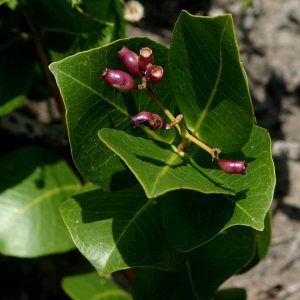
Syzygium guineense. Photo: Bart Wursten. Source: Flora of Zimbabwe.
Also of interest and distinctive in this genus, are the prominent stipules enveloping the leaf bud which usually fall as the leaf unfolds, leaving a characteristic scar. We noted the tangled clusters of something on Zizigium guineense and learned that these ugly, deformed “witches brooms” are in fact the remains of parasitized flowers. We noted also that the growing ends of the young branchlets are often flattish. On our way back for lunch we collected Grewia stolzii in flower, another rather unusual tree. It has a rather larger flower than most members of this genus, and they are white, but these are not the petals, or dear! The petals are small and green, and rather insignificant. What you see are the white sepals, with green undersides. Thank you Helen and Alan for providing us with such an interesting and invigorating start to 1989.
-D.Hall
SOIL INFORMATION FROM WILD TREES IN ZIMBABWE
Reproduced with acknowledgement and thanks to Eng. D. J. Shelton
Introduction
With the arrival of computers and of engineers new to our local scene, both indigenous and expatriate, the writer has noted a fall off of purely local knowledge. The new arrivals tend to be long on computer brilliance, but often short on basic engineering grasp and plain horse sense. One piece of purely local knowledge which could be spot lighted to advantage is an association between some common indigenous trees, and the engineering properties of the soils in which they grow.
Distribution of Wild Trees
Fundamental to the incidence of wild trees is climate. Climate is a function of geographical situation. Things like altitude, rainfall, frost incidence, daylight hours. But if these were the only criteria there would be, for example, the same mix of trees all over Harare. But there is not. Topography has some effect, and may directly affect climate, but the key to the natural occurrence of wild tree species is certain soil properties. Some of these soil properties have engineering interest, so it is possible to gain a useful introduction to soils on a site from an observation of the naturally occurring indigenous trees on it.
It should also be understood that although the engineering properties of a soil may remain constant from one part of the country to another, the climatic variation may be sufficient for a different tree type to dominate. For this reason, more than one “useful” tree species may indicate the same thing to the engineer, but in a different area.
Useful tree species
Common names are used to describe the trees. For the more precisely minded the more exact botanical name is given in the Appendix. Useful trees come in two kinds – the first sort, is the sort of tree which produces a woodland which is “typified” by the tree, such as msasa woodland, or mopane woodland. The second sort is trees which occur more individually. These may nevertheless be very striking, and so act as “confirmers”.
Msasa Woodland
Msasa woodland is the clearest and commonest signal of well drained soils. Msasas occur on a variety of soils, but all are well drained, whether granitic (as around Marondera/Macheke) or not. Msasas occur both as fairly pure woodland, granites, high rainfall areas, or mixed with other trees like munondo and mufti which look rather similar (banded ironstone, epidiorites and similar red soils). This type of woodland covers thousands of square kilometres on the high veld.
This piece of information, that the tree identifies good drainage, is very useful. For the engineer, he can rest easy that he is not going to encounter nasty surprises such a periodic high water table or expansive soils, and even the possibility of collapsing soils is remote.
Msasas trees (and their lookalikes) signal good areas for housing development, easy trenching, okay for septic tanks, and few problems in road construction – unless there is rock to blast, that is.
Muhacha and Waterberry
These two trees occur exclusively on sand veld, that is sandy soils originating from the decomposition of the underlying granite. They signal progressively worse drainage character so that – Muhacha trees grow where the water table is periodically high. Waterberry trees grow where the water table is permanently high, or nearly so. These two trees clearly warn of ground water problems ahead. Start thinking of higher road profiles and porous pipes for road construction, a network of under drains for building; pumping during excavation and trenching. The drainage picture in granite areas is thus clearly read from a tree shading, msasa (well drained) – Muchacha (periodic high water table) – water berry (permanent high water table). The engineering problems associated with muhacha and water berry are concerned with drainage only. These trees are not associated with either clays or expansive soils. They may be associated with collapsing sands. The trees which go positively with granite-derived soils are here called the Granite Gang. (Table 1).
Zambezi Teak
Zambezi Teak grow mostly in the Victoria Falls/Hwange area, but they do occur in patches of woodland in the Midlands and even in the Mhondoro area, not far from Harare. To the logger, they represent a valuable hardwood, for swiss parquet flooring for instance, To the engineer, they identify single size, windblown sands of great depth – Kalahari sands in fact. These are well drained soils, but easily eroded.
Jesse Bush
This term denotes a tangled mass of non-thorny, deciduous bushes (rather than trees). Of the mixed species which go into it, bushes of the family Combretum predominate, having a characteristic 4-winged seed. Jesse bush occurs over very large areas of the lower rainfall, lower altitude zones, and it always indicates deep, sandy soils, good natural drainage, non-expansive soil. Easy going for roads, light buildings, landing strips and the like.
Mangwe
Mangwe trees form a dominant woodland type over lower rainfall, high altitude zones, on well drained soils derived from granite. Thus from Bulawayo to Plumtree, large areas are characterised by mangwe trees. They shade to msasas as you go north east, so that by Harare they are outnumbered but still occur, whereas by Rusape, they have become very infrequent.
Well drained soils
A good variety of dominant tree types clearly indicate the well drained soil areas. These are tabulated in Table 2. Nature does not arrange vegetation as a chess board, with clear black and white zones. The trees listed may shade with each other.
For example in Victoria Falls township there is found a blend of teak with msasa and jesse bush. All denote good drainage, but do not usually mix this way. Other trees serve as confirmers. They may be individually striking, but not occurring as a dominant tree species.
In the well drained soil group, confirmers are such trees as :
Baobab, usually found with jesse bush
Mukwa, growing with teak, or jesse bush, or msasa
Mountain Acacia, found only with msasa
Manje (mahobohobo) found with msasa
Mnondo, found with or instead of msasa
Mfuti, found with or instead of both msasa and mnondo
Scotsman’s rattle, only with teak
Pod Mahogany, occurs with msasa and mangwe
Sometimes msasas grow as scattered individuals, acting as confirmers with teak, or mnondo, or mufti. All the trees mentioned so far are rather positive soil pointers. They are climax species, which have come to be dominant in a particular area after a long period of evolution. It is possible to find isolated specimens out of place, but this is rare, and even small numbers of the “well drained” tree group are good pointers, “residual” representatives of the original tree cover in suburbs for example. This goes for Muhacha and waterberry too. A good degree of confidence is possible with all these trees.
Acacias – flat topped
All the acacias are more difficult to extract information from than are the broad leaved species previously listed. Flat topped acacias should be disregarded. There are too many of them, of similar appearance, to have confidence in identification. Additionally, they grow in a variety of soil situations.
Acacias – upright
Two acacias of upright aspect have some use as pointers. There are sweet thorn and white thorn. Where they are the climax tree, that is where they are established, spaced trees, in lush grassland, they indicate badly drained clays, usually expansive. In general, sweet thorn grows in black clays, over lying greenstone at variable depth, 5 to 3 metres. White thorn goes with less expansive clays, of great depth. Both types have to be treated with care, even suspicion, as soil indicators. Both will invade another environment, either following land clearing or (very common) following land abuse, such as over-grazing. Unfortunately the incidence of thorn vegetation in this sort of situation is on the increase.
Winter thorn
A special case of a distinctive acacia which positively identifies a soil is the winter thorn. It identifies deep alluvial silts, river flood plain areas such as at Mana Pools and Bream Pools on the Zambezi or at Malapati on the Mwenezi.
Mopane
The mopane tree is a tolerator of alkaline soil conditions. Frequently, but not always, the alkaline soil areas are associated with lower rainfall and higher temperatures. But mopane trees are to be found in the Highveld too, within 30km of Harare, for example, and within City limits in say Gweru and Kadoma. Where the soil alkalis sodium, the mopane tree is virtually the only tree that still grow. Pure mopane areas, particularly of scrub mopane, are in general areas of sodic soils which are sticky when wet, badly drained, and in every way the engineer’s nightmare. These sodic soils also tend to have an angle of repose near zero, so one may with reasonable confidence expect the worst in flat places trees exclusively by mopane trees. But there are other alkalis, and they need not be bad engineering news. Where mopane trees occur perhaps amongst other tree types, perhaps on stony slopes, no significance should be read into their presence.
Natal Mahagony
A specialist, this rather remote from the common round. The Natal Mahagony grows on sandbanks and river sand islands. Frequently found in association is the lead wood tree. Shadings of sand banks to silt deposits, favour mixed woodlands of winter thorn, lead wood and Natal Mahogany.
Ivory Nut
The ivory nut grows exclusively at lowish altitude. This tree marks areas of black clays, usually expansive. In a good many places the River Bush willow grows in the same conditions, overhanging the Zambezi above the Falls, but also along the Gweru River and even the Mukuvisi in Ardbennie.
Sharp Changes
Quite often, a sharp change of soil is clearly indicated by a sharp change of vegetation. Driving from Norton to Selous, for instance, one crosses the Great Dyke. The Dyke soils are sticky, heavy clays. On this road there is no well defined range of hills, as on the Harare – Banket road but clear lines of tree change mark entry and exit from the Dyke.
The many introduced trees such as pine, eucalyptus, jacaranda, wattle, syringa and so on were not evolved in situ under competitive circumstances of evolution. They convey no information at all about the soils they grow in.
Many indigenous trees provide useful pointers to the engineer about the soils they grow in, and a basic knowledge of a few common ones provides a worthwhile basis of “horse sense”. This paper lists some of them.
DICK HICKS CHAIRMAN


